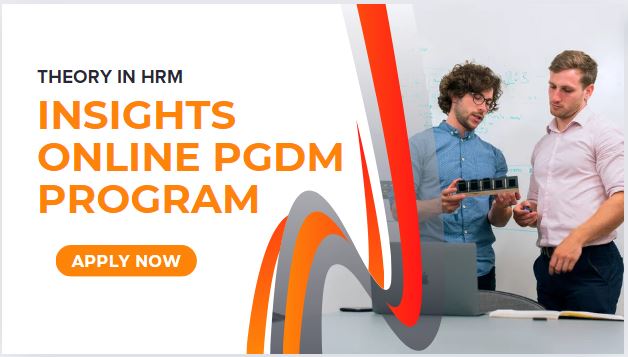
Introduction: The Dynamic World of Human Resource Management
Human Resource Management (HRM) has become more crucial in today’s rapidly evolving business landscape. As organizations strive to adapt to changing market conditions and workforce dynamics, the need for flexible and effective HR strategies has grown exponentially. One approach that has gained significant attention in recent years is the Contingency Theory of HRM. This blog post will delve into the intricacies of Contingency Theory and its application in HRM while highlighting the benefits of pursuing an Online PGDM in HRM to gain expertise in this area.
Understanding Contingency Theory in HRM
What is Contingency Theory?
Contingency Theory in HRM posits no one-size-fits-all approach to managing human resources. Instead, it suggests that the effectiveness of HR practices depends on various internal and external factors unique to each organization. This theory emphasizes the importance of aligning HR strategies with a company’s specific needs, goals, and circumstances.
Critical Principles of Contingency Theory HRM
- Adaptability: HR practices should be flexible and adaptable to changing circumstances.
- Context-specific: The effectiveness of HR strategies depends on the organization’s unique context.
- Alignment: HR practices should align with the company’s strategy and objectives.
- Continuous Evaluation: Regular assessment and adjustment of HR practices are necessary for optimal results.
Factors Influencing HR Practices in Contingency Theory
- Organizational size and structure
- Industry and market conditions
- Company culture and values
- Technological advancements
- Legal and regulatory environment
- Workforce demographics and diversity
Applying Contingency Theory in HRM Practices
Recruitment and Selection
In the context of Contingency Theory, recruitment and selection processes should be tailored to the organization’s specific needs. For example, a startup might prioritize candidates with diverse skill sets and entrepreneurial mindsets, while a large corporation may focus on specialized expertise and cultural fit.
Training and Development
The employee training and development approach should align with the organization’s goals and resources. A tech company might invest heavily in continuous learning programs to keep up with technological changes, while a manufacturing firm might emphasize on-the-job training for specific skills.
Performance Management
Contingency Theory suggests that performance management systems should be designed to suit the organization’s structure and culture. A hierarchical organization might use traditional top-down evaluations, while a more collaborative environment might benefit from 360-degree feedback systems.
Compensation and Benefits
The design of compensation and benefits packages should consider factors such as industry standards, company size, and financial resources. A startup might offer equity options to attract talent, while a well-established company might focus on comprehensive benefits and stability.
The Role of Online PGDM in HRM in Understanding Contingency Theory
Benefits of Pursuing an Online PGDM in HRM
- Flexibility: Online programs allow students to balance work and study, making it ideal for working professionals.
- Updated curriculum: Online courses often incorporate the latest trends and theories in HRM, including Contingency Theory.
- Diverse perspectives: Virtual classrooms bring together students from various backgrounds, enriching discussions on different organizational contexts.
- Practical application: Many online PGDM programs include case studies and projects that allow students to apply Contingency Theory concepts to real-world scenarios.
Key Areas of Study in an Online PGDM in HRM Program
- Strategic Human Resource Management
- Organizational Behavior and Development
- HR Analytics and Metrics
- Employment Law and Compliance
- Talent Management and Succession Planning
- Change Management and HR Transformation
Challenges in Implementing Contingency Theory HRM
Identifying the Right Contingencies
One of the primary challenges in applying Contingency Theory is accurately identifying the relevant factors that influence HR practices. This requires a deep understanding of internal organizational dynamics and external market forces.
Balancing Flexibility and Consistency
While Contingency Theory advocates for adaptable HR practices, organizations must maintain consistency to ensure fairness and compliance with legal requirements. Striking the right balance can be challenging.
Resistance to Change
Implementing new HR strategies based on Contingency Theory may need more support from employees and managers accustomed to traditional practices. Effective change management is crucial for successful implementation.
Measuring Effectiveness
Evaluating the success of HR practices under Contingency Theory can be complex, as the effectiveness may vary across different departments or over time. Developing appropriate metrics and evaluation methods is essential.
Case Studies: Contingency Theory HRM in Action
Tech Startup: Agile HR Practices
A rapidly growing tech startup implemented flexible work arrangements and a flat organizational structure to attract and retain top talent. This approach aligned with their fast-paced, innovative culture and allowed for quick decision-making and adaptability.
Multinational Corporation: Localized HR Strategies
A global company operating in multiple countries adopted different HR practices for each region, considering local labor laws, cultural norms, and market conditions. This approach helped them maintain a robust global presence while respecting local contexts.
Non-Profit Organization: Mission-Driven HR
A non-profit focused on environmental conservation aligned its HR practices with its mission by emphasizing values-based hiring, offering volunteer opportunities for employee development, and implementing sustainable workplace practices.
The Future of Contingency Theory HRM
Integration with AI and Machine Learning
As organizations increasingly adopt AI and machine learning technologies, Contingency Theory HRM may evolve to incorporate data-driven decision-making in identifying and responding to relevant contingencies.
Focus on Employee Well-being
With growing awareness of mental health and work-life balance, future applications of Contingency Theory HRM may emphasize tailoring wellness programs and support systems to individual employee needs.
Adapting to Remote and Hybrid Work Models
The shift towards remote and hybrid work arrangements will likely influence how Contingency Theory is applied in performance management, team collaboration, and organizational culture.
Conclusion: Embracing Contingency Theory for Effective HRM
In today’s dynamic business environment, the Contingency Theory of HRM offers a valuable framework for organizations to develop effective and adaptive HR strategies. By recognizing that there is no universal best practice in HR management, companies can tailor their approaches to their unique circumstances and goals.
For students and working professionals interested in mastering these concepts, pursuing an Online PGDM in HRM provides an excellent opportunity to gain in-depth knowledge and practical skills in applying Contingency Theory. As the field of HRM continues to evolve, those who understand and can implement flexible, context-specific HR practices will be well-positioned to drive organizational success and navigate the challenges of the modern workplace.
“The key to effective HRM lies not in finding the one perfect approach, but in developing the ability to adapt and align HR practices with the ever-changing needs of the organization and its people.”
By embracing Contingency Theory and continuously refining HR strategies, organizations can create work environments that are productive, efficient, and responsive to the diverse needs of their workforce and the demands of the market.


